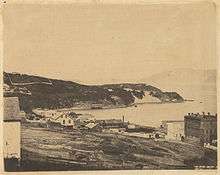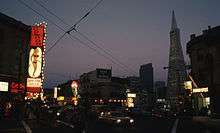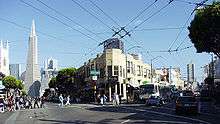North Beach, San Francisco
| North Beach | |
|---|---|
| Neighborhood | |
|
Saints Peter and Paul Church in North Beach. Baseball legend and neighborhood native Joe DiMaggio was photographed there with Marilyn Monroe after marrying her at City Hall in 1954. | |
 North Beach Location within Central San Francisco | |
| Coordinates: 37°48′1.04″N 122°24′36.66″W / 37.8002889°N 122.4101833°WCoordinates: 37°48′1.04″N 122°24′36.66″W / 37.8002889°N 122.4101833°W | |
| Country |
|
| State |
|
| City and county | San Francisco |
| Government | |
| • Supervisor | Aaron Peskin |
| • Assemblymember | David Chiu (D)[1] |
| • State Senator | Scott Wiener (D)[1] |
| • U. S. Rep. | Nancy Pelosi (D)[2] |
| Area[3] | |
| • Total | 0.492 sq mi (1.27 km2) |
| Elevation[4] | 16 ft (5 m) |
| Population [3] | |
| • Total | 18,915 |
| • Density | 38,000/sq mi (15,000/km2) |
| Time zone | Pacific (UTC-8) |
| • Summer (DST) | PDT (UTC-7) |
| ZIP codes | 94111, 94133 |
| Area codes | 415/628 |
| GNIS feature ID | 1659245 |
North Beach is a neighborhood in the northeast of San Francisco adjacent to Chinatown, Fisherman's Wharf and Russian Hill. The neighborhood is San Francisco's "Little Italy", and has historically been home to a large Italian American population. It is still home to many Italian restaurants today, though many other ethnic groups currently live in the neighborhood. It was also the historic center of the beatnik subculture. Today, North Beach is one of San Francisco's main nightlife districts as well as a residential neighborhood populated by a mix of young urban professionals, families and Chinese immigrants connected to the adjacent Chinatown.
The American Planning Association (APA) has named North Beach as one of ten "Great Neighborhoods in America".[5]
Location
North Beach is bounded by the former Barbary Coast, now Jackson Square, the Financial District south of Broadway, Chinatown to the southwest of Columbus below Green Street, Russian Hill to the west, Telegraph Hill to the east and Fisherman's Wharf at Bay Street to the north.
Main intersections are Union and Columbus, the southwest corner of Washington Square, Grant Avenue and Vallejo Street.
The somewhat compact layout of the neighborhood consists of apartments, duplexes, and Victorian homes dating from the 1920s, when residents rebuilt the neighborhood from its complete destruction after the earthquake and fire of 1906.
History


Originally, the city's northeast shoreline extended only to what is today Taylor and Francisco streets. The area largely known today as North Beach was an actual beach, filled in with landfill around the late 19th century. Warehouses, fishing wharves, and docks were then built on the newly formed shoreline. Due to the proximity of the docks, the southern half of the neighborhood south of Broadway was home of the infamous Barbary Coast.[6]
Following its reconstruction after the 1906 earthquake, a large number of Italian immigrants created the Italian character of the neighborhood that still exists. Prominent Italian Americans that came from the neighborhood include baseball legend Joe DiMaggio who grew up in the neighborhood and briefly returned to live there with his wife Marilyn Monroe during the 1950s, as well as former San Francisco mayor and politician Joseph Alioto plus others from the prominent Alioto family.
During the 1950s, many of the neighborhood's cafes and bars became the home and epicenter of the Beat Generation and gave rise to the San Francisco Renaissance. The term "beatnik" originated from the scene here and was coined in a derogatory fashion by famed San Francisco Chronicle columnist Herb Caen. Many of that generation's most famous writers and personalities such as Jack Kerouac, Allen Ginsberg, Gregory Corso, Neal Cassady lived in the neighborhood. Another poet from this generation, Lawrence Ferlinghetti, founded the City Lights Bookstore that still exists today on the corner of Broadway and Columbus as an official historic landmark and serves as one of the main focal points of this generation.
During the 1960s a notable night spot was The Committee, an improvisational theatre group founded by alumni of The Second City in Chicago. The Committee opened April 10, 1963 at 622 Broadway in a 300-seat cabaret theater.
The Broadway area also created innovations for the strip club industry. The Condor Club, on the corner of Columbus and Broadway, was opened in 1964 as America's first topless bar, which it is again today. The Lusty Lady was the first striptease club to be structured as a worker cooperative, which meant that it was managed by the dancers who worked at that peep-show establishment. Broadway strip clubs owe their legacy to the Barbary Coast, which was located just one block south on Pacific Street during the late 19th-century.
In the 1970s and 1980s Broadway was the location of many live music clubs, like the Stone, and a punk rock club called the Mabuhay Gardens.
Since the 1980s, and much like Manhattan's Little Italy, due to a decrease in emigration from Italy and gentrification, the neighborhood has seen its native Italian American population rapidly shrink, while neighboring Chinatown has been rapidly expanding north into the neighborhood south of Broadway and along Stockton Street causing a major demographic shift to a mix of mostly Chinese and young professional population, although some, albeit very few, Italian Americans remain.
Paul Kantner was living in North Beach in an apartment unit above Al's Attire at the corner of Grant Avenue and Vallejo Street at the time of his death, and was often a patron of nearby Cafe Trieste.[7]
Attractions and characteristics

Events
- The North Beach Festival street fair on Grant Avenue and Columbus Avenue usually held on Father's Day weekend in June is one of the city's largest. It is also considered one of the nations oldest street fairs.
- The neighborhood also hosts a large Columbus Day/Italian American heritage day parade along Columbus Avenue to San Francisco Maritime National Historical Park.
Population
The neighborhood still retains an Italian character with many Italian restaurants, cafes, and bakeries that line Columbus Avenue and Washington Square.
Religious institutions and sites
- The National Shrine of Saint Francis of Assisi, the city's namesake, is located on Vallejo Street.
- Known as "The Italian Cathedral of the West", Saints Peter and Paul Church is located on the north side of Filbert Street in front of Washington Square. Joe DiMaggio married his first wife there, and came for photos after his marriage to Marilyn Monroe. Saints Peter and Paul is considered a San Francisco landmark and an emblematic tie to the neighborhood's Italian American past.
Secular institutions and sites
- An alleyway between Columbus and Grant Avenues is named for Beat Generation writer Jack Kerouac, who once lived there and frequented the famous City Lights Bookstore on the corner of Columbus and Broadway as well as the numerous nearby bars and coffee shops.
- Broadway east of Columbus Avenue still serves as one of the city's main nightclub districts and offers restaurants, blues clubs, strip clubs, nightclubs, and jazz clubs.
- The Academy of Art University has at least one building in the area, across the street from Pier 39.[8]
- The San Francisco Art Institute is located in the northern end of North Beach, on Russian Hill.
See also
- San Francisco crime family
- 49-Mile Scenic Drive
- Barbary Coast
- The Saloon
- Telegraph Hill
- Vesuvio Cafe
References
- 1 2 "Statewide Database". UC Regents. Retrieved December 8, 2014.
- ↑ "California's 12th Congressional District - Representatives & District Map". Civic Impulse, LLC.
- 1 2 "North Beach (NoBe) neighborhood in San Francisco, California (CA), 94111, 94133 detailed profile". City-data.com. Retrieved March 27, 2015.
- ↑ "North Beach". Geographic Names Information System. United States Geological Survey. Retrieved January 5, 2015.
- ↑ "North Beach: Authentic Character Is Intact 150 Years Later". American Planning Association. 2007-10-02. Retrieved 2007-10-16.
- ↑ Estavan, Lawrence (1 January 1991). "The Italian Theatre in San Francisco". Wildside Press LLC. Retrieved 20 November 2016 – via Google Books.
- ↑ "RIP: Paul Kantner, Jefferson Airplane Co-Founder & North Beach Regular | Hoodline". hoodline.com. Retrieved 2016-02-15.
- ↑ "Academy of Art University Campus Map" (PDF). academyart.edu. Academy of Art University. Retrieved 23 November 2016.
External links
| Wikivoyage has a travel guide for San Francisco/Chinatown-North Beach. |
| Wikimedia Commons has media related to North Beach. |
- North Beach Yahoo Maps
- North Beach Neighbors a San Francisco Neighborhood Organization
- Surrounded by Sound: Aurally Exploring the Barbary Coast at en fuego magazine
- Historic North Beach and Telegraph Hill photographs by photographer JB Monaco
- Dave Archer (2002). "Janis Joplin". DaveArcher.com. Retrieved 13 January 2013. (Painter Dave Archer recalls working at the Fox and Hound (later called Coffee and Confusion) in North Beach, in various capacities, and of his memories of Hoyt Axton and Janis Joplin, who got their starts in San Francisco at that club.)
- Dave Archer (2002). "The Fox And The Hound And The Coffee And Confusion". DaveArcher.com. Retrieved 13 January 2013. (Painter Dave Archer recalls living and working in North Beach, San Francisco, and the characters he met there (some famous, many up-and-coming and later famous).)

.svg.png)
